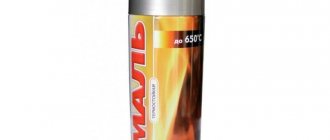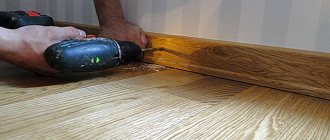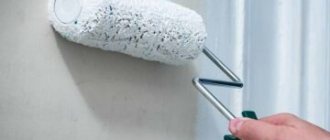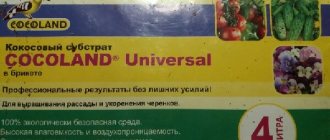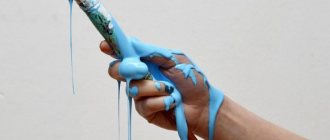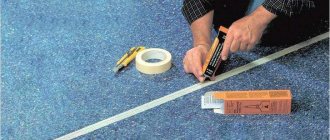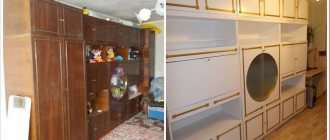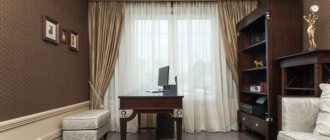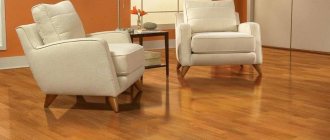Restoring a plastic car bumper that has split into several parts, with missing fragments or broken fasteners is best left to professionals. Do-it-yourself bumper soldering repair makes sense for small cracks, chipped area up to 10 cm², provided that most of the pieces were collected. Before you solder the bumper on your car yourself, you need to find out what is it made of, select the appropriate tool and solder. In this article we will describe in detail how to solder a plastic bumper in different ways, depending on the material and the degree of damage.
How can you solder a bumper on a car?
To properly solder a bumper with your own hands, first of all you need to find out what it is made of . Markings on the inside of the part will help with this. Depending on the material, the optimal repair technology and type of solder are selected. The latter should match the composition of the part as much as possible.
You can solder a plastic bumper with your own hands, using ready-made filler rods for different types of plastic or “donor” material from pieces of another bumper, fragments of lockers (for polypropylene bumpers), etc. Using fiberglass and epoxy or polyester resin, you can seal most types of plastic.
When using incompatible materials, the defect may worsen, for example, if the melting temperature of the repair plastic exceeds the melting temperature of the bumper material!
This table will help you determine the material and select solder for bumper repair based on the markings:
| Bumper markings | Bumper material | What is the best way to solder? | Soldering Features |
| PAG6, GF15, GF30 and ABS | Hard plastics (acrylic nitrile styrene, polyamide, etc.) | A hot air gun, a torch or a powerful soldering iron that provides heating of 500 ℃. Gluing with composite material is possible. | Hard plastics have a high melting point and must cool naturally. |
| PP or PPTV | Polypropylene | An ordinary 80 W soldering iron, a hair dryer with a nozzle. | Polypropylene can be soldered well even without the use of reinforcing material (if there are no holes), and it is important to observe the temperature regime. |
| PVC | Polyvinyl chloride | A PVC bumper can be soldered with a rod, but the seam needs to be reinforced due to the not very high strength of the connection. | |
| PUR | Polyurethane | Hot air gun or soldering iron with precise temperature control, hot stapler. | When repairing a polyurethane bumper, it is important to prevent the part from overheating. Polypropylene is difficult to weld and solder, so the seam must be properly reinforced. |
| No markings | Fiberglass (fiberglass and polymer resin) | Fiberglass and resin | Fiberglass parts are glued together using glass fabric impregnated with polyester or epoxy resin, applied in several layers. |
Primer
Before covering the bumper with primer, it is thoroughly washed with water and allowed to dry. Then apply the primer, let it dry, sand the primer with 800 grit sandpaper. Wash the bumper again with water and then apply a second coat of primer. When the primer is completely dry, the bumper is inspected using a lamp; the bumper should have a perfectly flat surface.
Tips and life hacks for soldering a bumper
The tips below will help you properly repair a crack or hole in the bumper. Thanks to them, you can achieve high seam strength and durability.
- When choosing how to solder a bumper on a car with your own hands, consider the melting point of the material.
The lower it is, the more accurate the adjustment of the heating of the tool must be so as not to damage the part. For example, ABS can be soldered with almost any hair dryer, and polyurethane can only be soldered with a stable temperature of about 200 degrees. To prevent overheating, it is better to first set the temperature below the operating temperature, and then increase it gradually. Reinforcing a bumper crack with copper wire - As a reinforcing material, use mesh or brackets made of corrosion-resistant metal. The best option is stainless steel, copper or brass.
- Cracks with smooth edges that close tightly and do not reach the edge of the part can be soldered without an additive. The melted plastic will give a fairly strong seam.
- To repair polypropylene bumpers, you can use homemade filler tapes, cut from lockers (fender liners) using metal scissors. For other materials, fragments of similar bumpers that can be found at auto dismantling yards are suitable.
- If you want to do without dismantling the part, you need to carefully remove the chamfers on the crack, since it will not be possible to solder the bumper without removing it. This option is suitable for polypropylene bumpers, which are easily soldered without reinforcement.
- Focus on strength rather than beauty, and leave a raised area in the seam area, since it is possible to solder a bumper without painting only if it is originally unpainted polypropylene or polyurethane. Other materials will still have to be puttied and painted after repair, after leveling the surface.
When painting the bumper yourself after soldering, be sure to consider the type of plastic and use the appropriate primer. If the technology is not followed, the bumper will quickly peel off. It is best to give the bumper to professionals for painting, since without a spray-drying chamber and a spray gun, high-quality painting of the part is impossible.
How to repair minor damage to a plastic car bumper
Bumper damage comes in many different types, from minor scratches and small dents to serious cracks. Small dents and scratches can be removed yourself.
If the car bumper is made of thermoactive plastic, then minor damage to it can be easily eliminated using the polishing method with special chemicals. means.
Related article: We remove chips and scratches on the car body with our own hands
For example, if there is a shallow scratch, it can be treated with WD-40 universal cleaner.
In order to polish a scratch or chip, you will need a sponge, a soft rag and a chemical reagent. First, you need to clean the damaged area from dirt and dust with a sponge and water. After applying chemical. spray or sponge. Next, the damaged area is intensively polished with a rag until no damage is visible on it.
The second way to eliminate small dents and scratches on a plastic car bumper is to straighten the damaged area with a hot air gun. The essence of the method is that the damaged surface is evenly heated with a hair dryer. Due to heat treatment, the damage is leveled and straightened.
The method is simple and does not require special skills to perform, but it is not without its drawbacks: there is a possibility of deformation of the plastic; heating with a hairdryer can only be used on unpainted areas.
Also, a wax pencil is considered a simple and inexpensive way to eliminate minor damage to a plastic car bumper.
With its help, scratches and chips are simply painted over. Chem. the composition of the pencil fills the damaged areas, leveling them with the general surface and forms a protective layer. The process of removing chips and dents with a wax pencil takes no more than 5 minutes.
Answers to frequently asked questions
How to solder the fastening (ear) of a plastic bumper?
In order to reliably solder the bumper fasteners without loss of strength, the repair site must be reinforced with reinforcement. You can use wire mesh, hot staples, or regular construction staples for this.
How to solder a large crack on a car bumper?
A large crack must be sealed, ensuring that its edges are tightened and reinforced. Large holes and breaks can be repaired using composite material (fiberglass or fabric + polyester resin).
Is it possible to solder a bumper with a metal rod?
It only makes sense to use a non-melting metal rod as a heating element. You should not solder plastic parts with metal solder.
putty
Puttying a plastic bumper is done to restore the geometry of the bumper and level its surface. The putty is applied to the area of the bumper where the damage is located, smoothed out, allowed to dry, then sanded using sandpaper. In most cases, putty is applied in several layers.
What bumper damage can be repaired at home?
Without the help of car service specialists, it is possible to eliminate various types of bumper defects. The easiest to restore are scratches, which can be almost imperceptible superficial or deep, reaching the inner layer of the part. Repair in the second situation will be more difficult, since deep scratches often turn into cracks. If the bumper is cracked through and through, it is not recommended to use the car until the problem is completely eliminated, since when the car is moving, a vibration load is applied to the front part of the body, which can cause the crack to expand. This will affect the condition of the entire body and its performance characteristics.
In addition to scratches and cracks, dents, punctures and chips may form on the part. Dents appear as a result of strong external influence and must be corrected. Breakdowns and chips often occur due to a collision with an obstacle located at an angle.
How to choose adhesive for car sealing
You can seal a damaged bumper using adhesive solutions from different manufacturers. When choosing the right glue, you should familiarize yourself with all the suitable products and decide on the basis of the characteristics of the solutions.
Weicon Construction
Weicon Construction adhesives are used to bond surfaces made of a variety of materials, including coated metal, plastic and composite materials. The advantages of this adhesive solution include the following:
- strong bonding of large surfaces;
- elasticity and impact resistance of the formed connection;
- resistance to extremely high temperatures and preservation of structure when heated;
- the ability to glue different materials to each other;
- economical consumption;
- absence of solvents in the composition;
- fast fixation and hardening at room temperature.
Weicon structural adhesive comes in two forms. An option that does not require mixing is suitable for working with automotive parts. This product is applied to one of the parts to be glued, and the activator is applied to the other.
The hardening process begins only upon joining, which is convenient for working with tight-fitting parts.
AKFIX
The AKFIX adhesive solution contains cyanoacrylate, which gives the substance viscosity. Due to its structure, the solution is suitable for use on a vertical plane. After application to the surface, the glue does not flow or drip and immediately forms a strong connection. AKFIX glue can be used to repair automotive materials with a porous structure or a rough coating. To speed up the process of gluing the bumper parts, it is recommended to additionally use an activator aerosol.
Power Plast
The main purpose of Power Plast adhesive is to repair and restore automotive and household plastic parts. The solution is used in situations where the use of simple glue or soldering has proven ineffective. The composition of the Power Plast solution ensures ease of use, rapid drying of the applied mass and a strong connection of the treated parts of the car bumper. The solution is suitable for repairing plastic parts, regardless of their shape. Power Plast can also be used to restore missing elements.
"Moment"
The adhesive composition “Moment” is a product of a domestic manufacturer. Distinctive characteristics are the versatility of use and the reliability of the connection formed. “Moment” is highly resistant to low temperatures and moisture, which improves the strength of the connection even when the vehicle is operated in non-ideal conditions. Before using Moment glue to restore a car bumper, careful preparation of the working surface is required.
See also
Properties and purpose of Litokol glue, review of popular brands and how to use
Sealing process - preparation
Before sealing the bumper with fiberglass, we recommend conducting a trial compatibility test on a small area of the damage. To determine how to glue the body bumper, carefully study the manufacturer's instructions. The adhesive material must match the surface type of the part.
If there are body kits at the site of damage, they must first be secured and only then removed. At the same stage, accurately determine the material of the spare part to select the desired adhesive base.
This information is on a stamp on the inside of the product. When the mixture is selected, all that remains is to use it correctly in order to correctly restore the spare part after damage.
In order for the repair to last as long as possible, the bumper will have to be pre-treated. The part is disconnected in advance.
Carry out mandatory training:
- thoroughly clean the car buffer from dirt accumulations;
- remove residual oil and dust;
- let the parts dry;
- wipe it with a chemical to degrease it;
- grind the broken surface with an abrasive or a grinding machine;
- if the cracks are too deep, we recommend drilling them out, protecting the spare part from increasing damage.
With the listed procedures, you will achieve stronger adhesion of the glue to the surface, which will guarantee the quality and long service life of the part.
How to glue a bumper: let's get started
Once the surface has been pre-treated, it is time to begin the bulk of the restoration process. Cover the damaged area of the spare part with a primer and wait until the substance dries completely.
The second option: seal the crack on the bumper from the outside so that glue does not leak out of it. To do this, use foil. Once the adhesive has dried, the material must be removed.
Primary gluing from the inner surface of the buffer is carried out with a composition having reinforcing properties. To do this, we recommend using a composition based on epoxy resin with a high degree of adhesion.
If you have previously decided to abandon priming work, then carefully move the damaged areas towards each other
Sometimes the cracked parts are held together with metal staples. However, fixing the two parts from the outside is done with standard paper tape. He will carefully secure the edges of the surface at the same level before painting. After gluing the hole from the inside, the tape will be easier to remove than the staples.
When both parts of the car are securely fixed, apply the adhesive mixture to both parts of the damaged part. Before it dries, glue a metal or synthetic mesh to strengthen the seam.
This can be a painting mesh, which also needs to be treated with adhesive on top. It is impossible to predict the drying time, since each chemical composition takes its own time to dry.
Final stage
When the crack is glued and the adhesive solution is completely dry, the car buffer remains visually unattractive. There is no need to sound the alarm - this is natural, because there is still finishing work ahead.
Let's get started:
- Remove any excess compound on the plastic, carefully cut it off or sand it.
- Prepare the surface of the spare part for further painting. To do this, use a primer, putty or other materials for this purpose.
- The car buffer must be painted according to technology. Such paints are available in car dealerships.
Detailed work on painting a bumper with your own hands in the video:
Results
Repairing a buffer at home is not a difficult task. Therefore, if you have minimal experience in this matter and follow all the instructions, you can quickly restore the part. And you won’t have to spend money on paying a car mechanic.
Glue for car parts has significant advantages. It is cheap, its purchase will not affect the family budget. The method of sealing a cracked buffer with an adhesive mixture is in no way inferior to sealing.
We recommend watching the video instructions on how to glue a bumper with glue yourself:
Mechanical impact on a car bumper as a result of an accident or collision with a high curb leads to the need for repairs. In order not to spend money on car service services, many car owners prefer to do the repairs themselves. Detailed instructions on how to properly glue a bumper with your own hands at home will help you avoid mistakes.
Additional tuning elements
Motorists, trying to give their vehicle a unique design, tune the bumper. Basically, these alterations concern the installation of the following elements:
- Lip. It is a kind of protrusion, which is located at the bottom of the protective structure. It is made of fiberglass and polyurethane foam, as a result of which the lip is primed and painted to match the color of the car.
- Diffuser. Decorative trim for the lower part of the rear bumper. Foamed PVC is used to create it. Markings are created on the material, after which the sheet is heated with a construction hairdryer and the parts are given shape. They prime and paint, and then attach it to the car using sealant.
- Fangs. A decorative element that is installed on both metal and plastic body elements. For mounting on “plastic”, fiberglass is used. To install fangs on iron parts, use metal and a welding machine.
Also, to give the car an individual look, stickers are placed on the bumpers, or parts are covered with carbon fiber.
Final work
After the glue has dried and checked the tightness of the resulting seam, you need to remove traces of the work.
To do this, they begin the final stage of restoring the damaged body part. It consists of the following steps:
- Remove the foil from the outside of the bumper.
- Using a grinding wheel or sandpaper, polish the seam to the level of the rest of the bumper surface.
- If necessary, fill the uneven areas with putty. To do this, use wide and narrow spatulas.
- A layer of primer is applied to the treated surfaces.
Paint the treated area
It is important to ensure that the painted area does not stand out on the surface of the body kit
Damage to the bumper spoils the appearance of the car. Restoring a broken body kit can be done at a service center. On average, for 5,000 rubles, you can seal a crack and remove traces of repairs. To save money, the operation is performed at home. The car enthusiast will need to be patient and careful, which will lead to an acceptable result.
How to properly repair a cracked plastic bumper with your own hands
Restoration will only be considered high-quality when the structure is monolithic not only outside, but also inside. Think about this idea, and you will understand that mesh, staples and other reinforcing tricks cannot provide this. That is why soldering using filler plates (rods) and gluing using special kits have confidently replaced techniques that we do not recommend for use.
Crack preparation and method selection
The successful result of any technology for repairing a plastic bumper is determined by the preparatory stage. If you leave the damage as they say “as is” and immediately start soldering or gluing, then, alas, all efforts will be in vain. That is why you should not trust the restoration to the first service station you come across, but it is even better to take the initiative into your own hands.
There is nothing complicated in preparing a crack:
- Drill out the end of the damage. This must be done without fail, since the hole will help prevent further cracking of the bumper under the influence of vibrations.
- Sharpen the edges along the outline. This increases the contact area with the glue or molten filler rod. This means that the strength of the repaired area as a whole increases. You can sharpen it with an angle grinder or a piece of medium-grit sandpaper.
There are no specific recommendations regarding the choice of one of the effective recovery technologies. You can start from the existing equipment: if you have an industrial hair dryer, then it will be cheaper to solder. The situation can be considered a matter of taste in the absence of any devices, since gluing and soldering guarantee an equally long-term result.
How to solder correctly
What do we mean by the word “competently”? This is a sign of quality in the form of a homogeneous surface obtained. You can draw a parallel with the question of how to remove scratches from car glass with your own hands. In recognition of the high-quality work done when polishing glass, we recorded the absence of a lens effect upon completion of the work. Here, at the finish, the plastic should be exactly one whole without any putty or other finishing.
To achieve this result, follow simple rules:
- Connect the cracked parts into a single whole and grab with a regular soldering iron from the side opposite the front.
- Cut the rod into small pieces 15-20 cm long.
- Place the filler strip against the crack, heat it with a hairdryer and press it with the palm of your hand hidden in the glove.
- Make several fixing stitches. Cut the rod into several pieces 5-7 cm long and solder them across the crack in small increments (no more than 5 cm).
- Repeat the steps described for the front side, excluding the section with soldering the transverse strips.
- Sand the front surface until the seam is aligned with the bumper profile.
As equipment, experts recommend using a special hair dryer with a thin nozzle. However, you can also narrow the heating zone in the case of a household hair dryer. To do this, just select a suitable head from a set of keys.
In everyday life, we came across situations where savvy craftsmen found a replacement not only for a special hair dryer, but also for filler materials. So, instead of a rod, they used plastic shavings from the bumper being repaired, cut in an inconspicuous place. Then the resulting material was melted and the crack was filled on both sides. Practice shows that this economical option is not inferior to proprietary technology.
How to seal correctly
For gluing it is necessary to use a special repair kit. The kit for restoring plastic from ZM has earned special respect online, so we take its instructions as a basis.
To begin with, what does a repair case for repairing cracks in plastic bumpers from ZM include:
- Two-component adhesive.
- Glass tape with a sticky backing.
- Adhesion activator.
- Reinforcing tape.
Having prepared and degreased the damage to be repaired (for example, with acetone, waiting for it to dry completely), we proceed to restoration:
- Glue the crack with reinforcing tape from the front side. You will get a rigid structure with which you can work.
- Turn the bumper over - further work will be done on the opposite side to the front.
- Degrease the area around the crack and wait until the solution dries completely.
- Apply the adhesion activator in two layers with intermediate drying for a few minutes.
- Mix the glue components in a 1:1 ratio and apply the mixture to the defective area.
- Immediately apply glass tape.
- Repeat the previous two steps twice. The result should be 3 layers of glue and 3 layers of glass tape.
- Take a break for two hours.
- Remove the reinforcing tape from the front side, degrease and apply glue in one layer without glass tape.
- After a day, grind the resulting seam until it is level with the surface of the bumper.
Rules for choosing an adhesive composition
When preparing to solve the problem of how to glue a bumper, it is important to correctly and carefully consider the purchase of the main component, we are talking about the fixing mixture. The solution must be fully suitable for the material from which the part is made, and also meet other generally accepted requirements.
Initially, a person checks whether the glue can create an integral structure, whether it will not burst in severe frosts, and how high its resistance to increased temperatures is.
As the vehicle is driven, the layer will certainly become exposed to an aggressive environment in which drops of oil or gasoline occur; the frozen seam should not be destroyed under the influence of these reagents.
